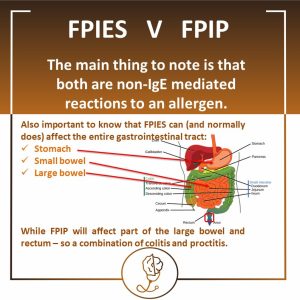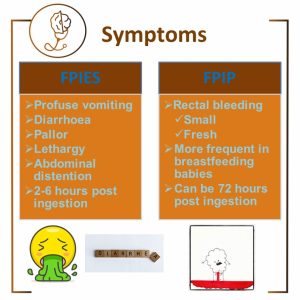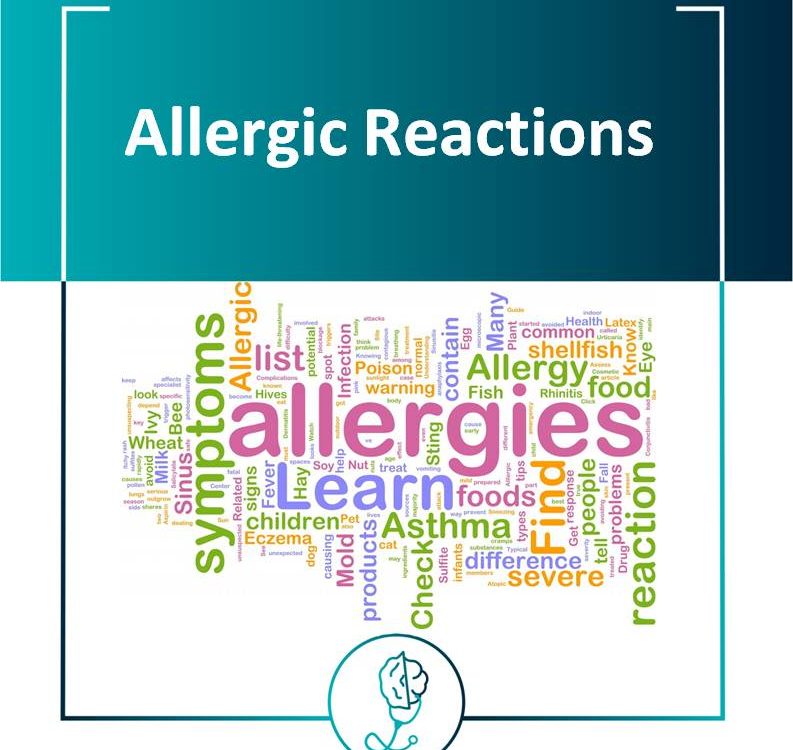FPIES and FPIP

Which came first: The Chicken or The Egg?
19/02/2021
Gastroesophageal Reflux (GOR)
25/02/2021Simple Food Protein Induced Enterocolitis Syndrome (𝐅𝐏𝐈𝐄𝐒) or Food Protein Induced Proctocolitis (𝐅𝐏𝐈𝐏) is often mistaken for a viral infection causing vomiting and diarrhoea, with occasional blood in the stool.
Often, and not wrongly, it may be diagnosed as a 𝘯𝘰𝘯-𝘐𝘨𝘌 𝘢𝘭𝘭𝘦𝘳𝘨𝘺, with the most common being CMPA.
- This is because it normally tends to have mild symptoms.
Important to note that severe 𝐅𝐏𝐈𝐄𝐒 is relatively rare and less common than Anaphylaxis!
𝐅𝐏𝐈𝐄𝐒 most common triggers:
- Milk
- Soy
- Rice
- But can be associated with a long list of food proteins
Most children will be able to tolerate the food causing the reaction by the age of 2 or 3 years old. In some cases, it may persist throughout life.
Children with recurrent episodes may suffer from poor growth and weight loss – failure to thrive.
Usually, children will recover very fast from an episode of 𝐅𝐏𝐈𝐄𝐒, as long as appropriate diagnosis and treatment are made.
For severe cases, the best treatment is fluid resuscitation.
- What does not work to treat them:
- Adrenaline auto-injector
- Antihistamines
- Steroids
- Antibiotics


Though you will often see all of them being used due to the worry it is either Anaphylaxis or Sepsis.
In the case of 𝐅𝐏𝐈𝐏, most symptoms tend to resolve by 6 months of age (50%) or 9 months of age (95%).
The advice is to reintroduce the causing food into the mother’s diet after an exclusion period of 6 months or give it to the child when reaching 12 months of age.
For both cases, if the child is formula fed be aware that:
- Medical and dietetic advice needs to be sought before a restriction diet is done
- It might take 2 weeks for improvement to be seen
- The child will need and Extensively Hydrolysed Formula (EHF – first choice) or eventually an Amino Acid Formula (AAF – second choice)
In the case of a breastfeeding mother, a restriction diet needs to be guided by a dietitian.
- This is to be sure appropriate nutrition (focusing on protein and calcium) is achieved.
For 𝐅𝐏𝐈𝐄𝐒, there seems to be a 30% chance of people involved to develop either 𝘢𝘵𝘰𝘱𝘪𝘤 𝘥𝘦𝘳𝘮𝘢𝘵𝘪𝘵𝘪𝘴 (eczema), 𝘢𝘴𝘵𝘩𝘮𝘢 or 𝘩𝘢𝘺𝘧𝘦𝘷𝘦𝘳 (allergic rhinitis).


